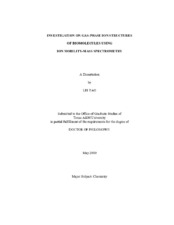| dc.description.abstract | IM-MS is a 2-D technique which provides separations based on ion shape (ion-neutral collision cross-section, Ω) and mass (m/z ratio). Ion structures can be deduced from the measured collision cross-section (Ωmeas) by calculating the collision cross-sections (Ωcalc) of candidates generated by molecular dynamics (MD) and compared with the experiment results.
A database of Ωs for singly-charged peptide ions is presented. Standard proteins are digested using different enzymes (trypsin, chymotrypsin and pepsin), resulting in peptides that differ in amino acid composition. The majority (63%) of the peptide ion correlates well with the globular structures, but some exhibit Ωs that are significantly larger or smaller than the average correlation. Of the peptide ions having larger Ωs, approximately 71% are derived from trypsin digestion and most of the peptide ions that have smaller Ωs are derived from pepsin digestion (90%).
We use computational simulations and clustering methods to assign backbone conformations for singly-protonated ions of the model peptide (NH2-Met-Ile-Phe-Ala-Gly-Ile-Lys-COOH) formed by both MALDI and ESI and compare the structures of MIFAGIK derivatives to test the ‘sensitivity’ of the cluster analysis method. Cluster analysis suggests that [MIFAGIK + H]+ ions formed by MALDI have a predominantly turn structure even though the low energy ions prefer partial helical conformers. Although the ions formed by ESI have Ωs that are different from those formed by MALDI, the results of cluster analysis indicate that the ions backbone structures are similar. Chemical modifications (N-acetyl, methylester, as well as addition of Boc or Fmoc groups) of MIFAGIK alter the distribution of various conformers, the most dramatic changes are observed for the [M + Na]+ ion, which show a strong preference for random coil conformers owing to the strong solvation by the backbone amide groups.
Ωmeas of oligodeoxynucleotides in different length have been measured in both positive and negative modes. For a given molecular weight and charge state, Ωmeas of the oligodeoxynucleotide ions are smaller than those of the peptides, indicating their different packing efficiency. A novel generalized non-Boltzman sampling MD has been utilized to investigate the gas-phase ion conformations of dGGATC based on the free energy values. Theory predicts only one low-energy conformer for the zwitterionic form of dGGATC- while dGGATC+ ions have several stable conformers in both canonical and zwitterionic form in the gas phase, in good agreement with the experiment. | en |


